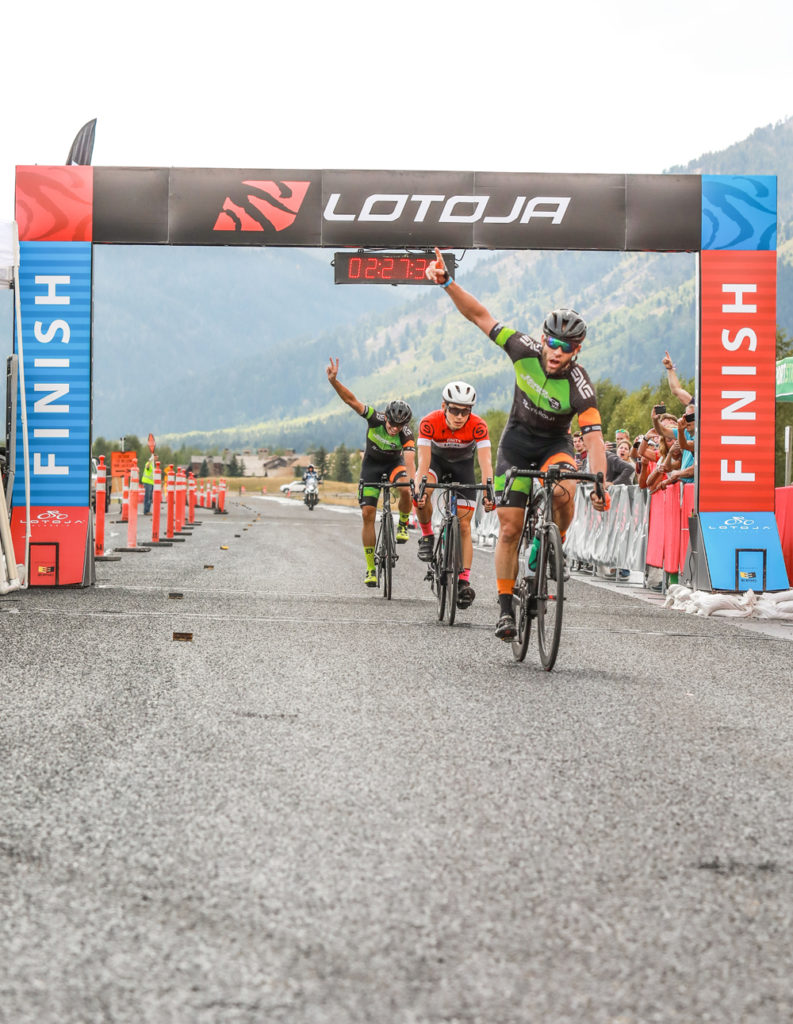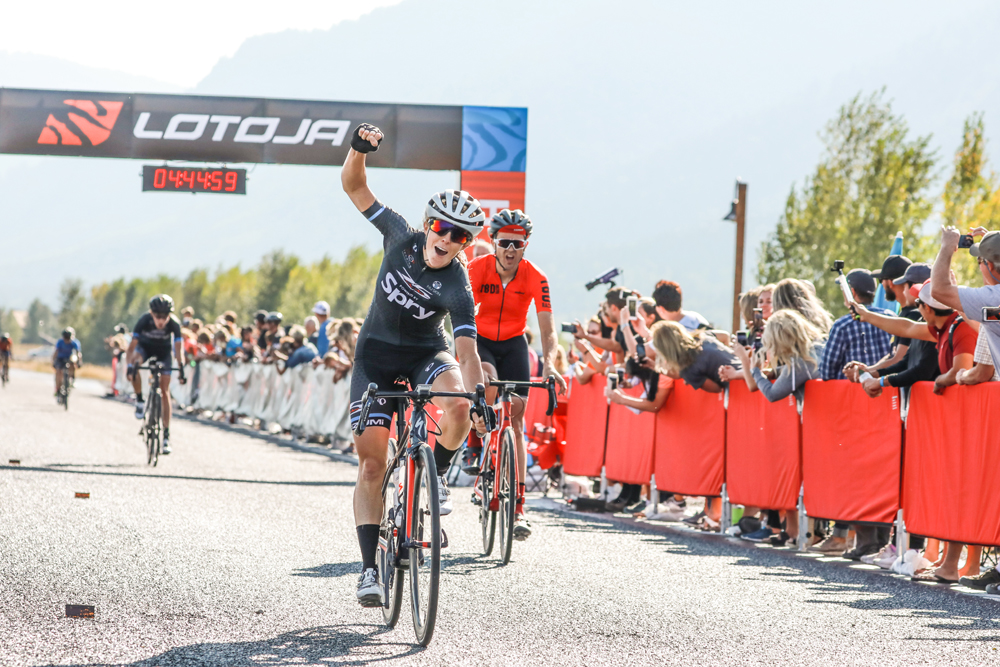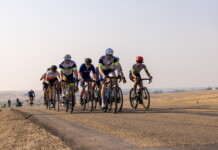Layton, Utah — More than 1,500 bicyclists from across the U.S. and two foreign countries will point their handlebars north toward Jackson, Wyoming, when they depart on Saturday, Sept. 7 in the 37th annual LoToJa Classic.
Ridden entirely in one day, LoToJa’s 207-mile (333-kilometer) course begins at Sunrise Cyclery in Logan, Utah, and ends at Jackson Hole Mountain Resort with the 13,776-foot high Grand Teton towering nearby.

The course winds on back roads through scenic northeastern Utah, southeastern Idaho and western Wyoming, and includes three mountain passes that total 35 miles and almost 10,000 vertical feet of riding uphill. While en route, cyclists also pedal through Utah’s Cache Valley, Preston and Montpelier, Idaho, and Wyoming’s Afton and Alpine before reaching Jackson Hole.
“It doesn’t matter if you’ve been racing for years, or are new to the sport, crossing LoToJa’s finish line is known to change lives,” said LoToJa Race Director Brent Chambers. “It is a challenging and beautiful event that presents a huge goal for every cyclist who enters. They must properly train and dig deep — and that includes those who just want to finish and cross LoToJa off their bucket list.”
Chambers, who has been race director and owner of LoToJa since 1998, said the race continues to be one of America’s most popular cycling events. Several thousand register every April, but less than 2,000 are accepted to keep LoToJa as a high quality cycling experience with a premium on safety.
The race director said it would be extraordinary if the men’s course record is broken again this year, and also the current women’s course record. A year ago, Spencer Johnson of Riverton, Utah, set the new men’s record of 8:18:29, taking off more than 24 minutes from the previous record of 8:42:31 set in 2017. Melinda MacFarlane of Salt Lake City set the current women’s course record of 9:35:00 in 2013.
Most of the other cyclists take 10-13 hours to ride LoToJa, with some coming in long after the finish line closes at 8:30 p.m. But despite pedaling all day, many return every year. For 2019, cyclists are coming from 37 states, some as far away as Maryland and North Carolina, Chambers said. There are also cyclists coming from Canada and the United Kingdom.
LoToJa began in 1983 by two Logan cyclists who wanted to create an enduring one-day bicycle race. They modeled it after European professional cycling’s five grand monuments: Milan-San Remo, Ronde van Vlaanderen, Paris-Roubaix, Liege-Bastogne-Liege and the Tour of Lombardy.
In LoToJa’s first year, seven cyclists competed and crossed the finish line near downtown Jackson. The winner was Bob VanSlyke of Logan who finished the 186-mile course in 9 hours. In 1986 the finish line was moved to Jackson Hole Mountain Resort, which pushed the race’s distance to over 200 miles.

Since then LoToJa has become one of America’s premier amateur cycling races. It has also become a major fundraiser for the Huntsman Cancer Foundation and for other health-related organizations. More than $2 million has been contributed to Huntsman alone by cyclists and sponsors. LoToJa also sponsors local fund-raising groups that assist the event.
Chambers said this year’s LoToJa again features multiple categories for USA Cycling license holders, plus a cyclosportive class, which consists of non-licensed cyclists who are either competing against riders within their age group, or are just riding for fun. A relay race and categories for tandem riders are also held.
This year’s race will have nearly 700 course volunteers, which includes 150 Ham radio operators from the Bridgerland Amateur Radio Club, he said. They provide uninterrupted communication throughout LoToJa’s mountainous and remote terrain.
Chambers stressed LoToJa wouldn’t be possible without its volunteers and the cooperation and assistance it receives from businesses, civic leaders, public safety officials and community volunteers.
He also emphasized that LoToJa’s top goal is to have a safe race for all cyclists, support crews and volunteers. Motorists traveling LoToJa’s course on Sept. 7 are asked to use caution when approaching cyclists. Groups consisting of up to dozens of riders may be encountered. Motorists are urged to pass carefully and to leave a safe distance between their vehicle, cyclists and other traffic.
To further increase safety on race day, the Idaho Transportation Department will restrict eastbound traffic on state Route 36 north of Preston between Riverdale and Ovid from 7 a.m. to 12:30 p.m. Eastbound traffic on US-89 between Montpelier and the Wyoming state line will also be restricted from 9 a.m. to 2 p.m.
The temporary travel restrictions were started years ago because SR-36 and US-89 are filled with eastbound LoToJa cyclists, Chambers said. Motorists are asked to use caution while traveling on these two roadways during LoToJa, and to anticipate encountering groups of cyclists. Cautious passing is advised to ensure safety for everyone.
Chambers defined “cautious passing” as slowing down, giving plenty of space (at least three feet) between the vehicle and cyclist(s), and patiently waiting for oncoming vehicle traffic to clear before pulling around a cyclist or group of cyclists.
LoToJa cyclists, plus their support crews, well-wishers, event staff and volunteers, represent an entourage of approximately 4,000 people, Chambers said. Several of the communities through which LoToJa passes organize roadside fundraisers to capitalize on the influx of visitors. The host cities of Logan and Jackson also enjoy a welcomed economic boost from the race, specifically restaurants and hotels.
According to Chambers, LoToJa is the longest one-day bicycle race in America that is sanctioned by USA Cycling, the sport’s governing body. It is estimated more than 19,000 cyclists have pedaled more than 6 million miles during LoToJa since the race began in 1983.
Last year’s oldest male cyclist to finish was 76 years old and the oldest female was 67. The youngest boy and girl finishers were 13 years old. The average age of a LoToJa participant last year was 45.
LoToJa’s route and additional information about the race are available at lotoja.com.












The USAC would not sacction the race in the first years because it was too long as a one day race. So – the organizers made it into a two stage, one day race. I did it three times starting the second year.
Comments are closed.